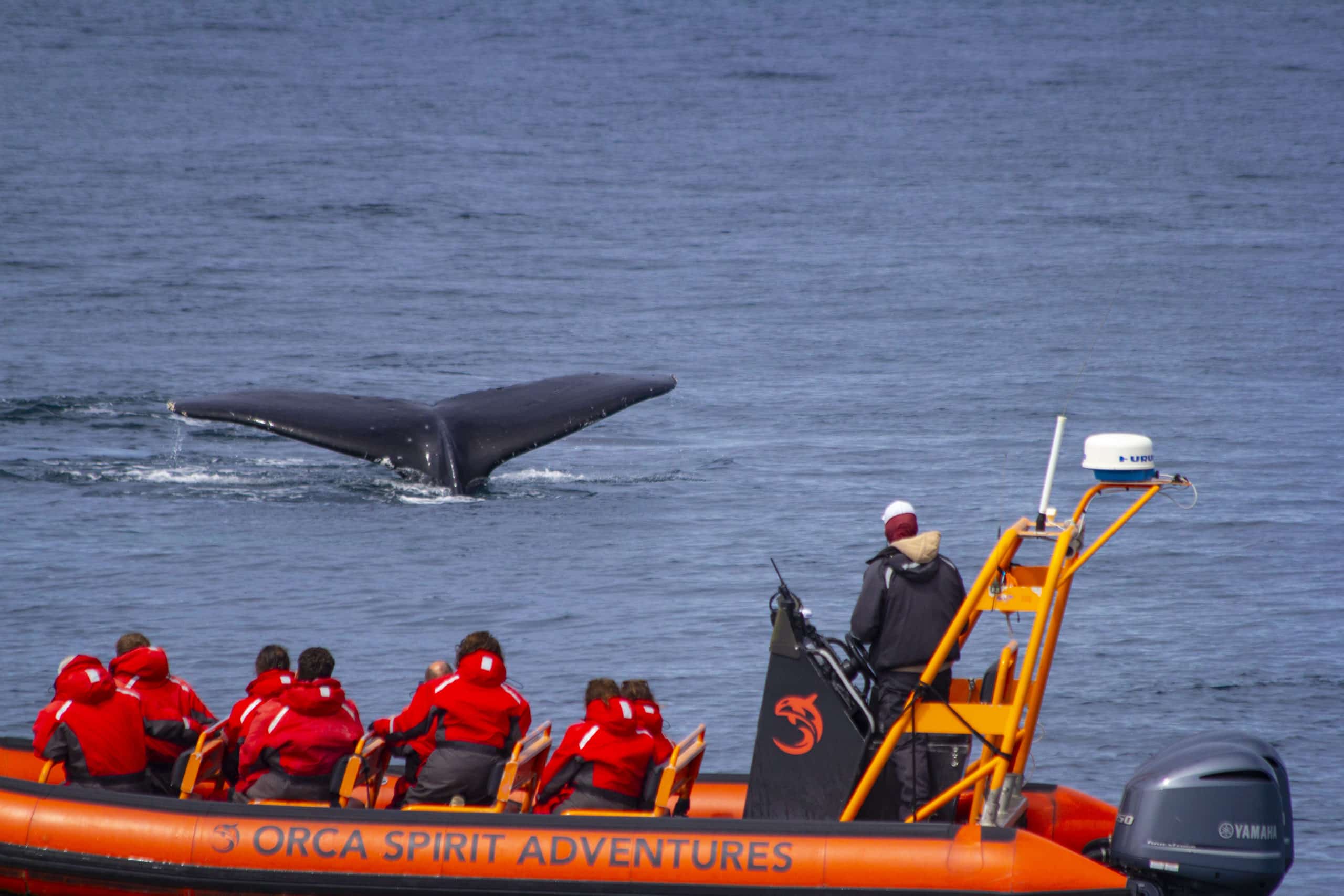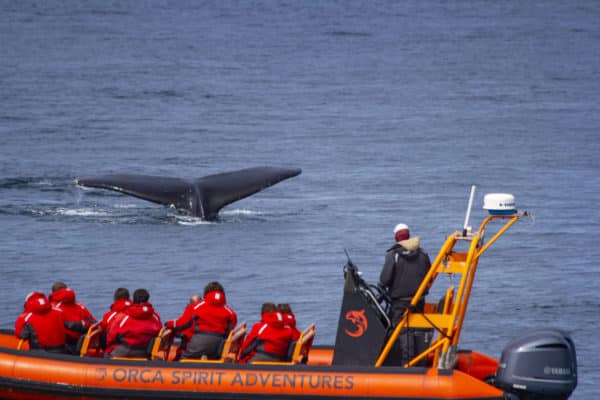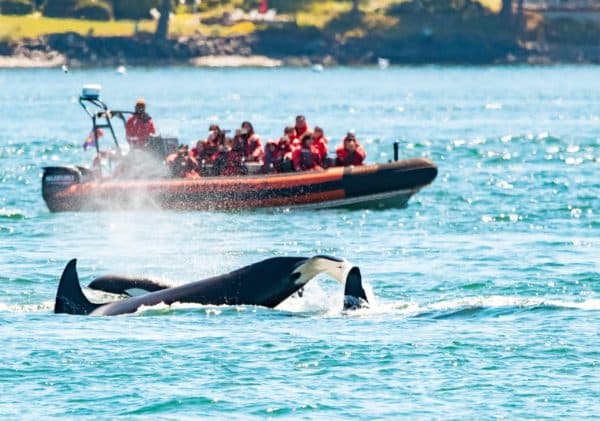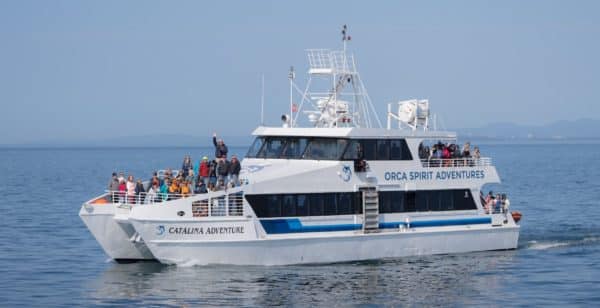Written by: Liam Hubbert, Onboard Naturalist
Whale watching is an unforgettable experience, offering a front-row seat to witness some of the ocean’s most majestic creatures in their natural habitat. Whether spotting the powerful splash of a humpback’s tail or catching a glimpse of an orca, every season brings unique opportunities to see these giants up close. But as thrilling as the adventure can be, the right clothing can make all the difference. The conditions on the water can change quickly, and dressing appropriately is essential for staying comfortable, safe, and fully immersed in the experience. In this seasonal guide, we’ll break down exactly what to wear for whale watching, so you’re prepared to enjoy every awe-inspiring moment, no matter the weather!
At Orca Spirit Adventures, you can choose between two types of tours: a covered vessel with an inner cabin and outer deck, or an open-air zodiac boat where you’ll be fully exposed to the elements for the entire three-hour trip. For zodiac tours, you’ll be provided with a full-body adventure suit for insulation, but it’s important to remember that what you wear under this suit can still depend on the season. Being properly prepared is crucial to maximizing your enjoyment, so your preparation should be tailored to both the type of vessel you’ve booked and the time of year you’re visiting!
What to Wear for Whale Watching in Spring
The whale-watching season kicks off in early spring, and while many people look forward to warmer temperatures as winter fades, spring weather on the water can be unpredictable. Some days may bring sunshine, while others might be cold and rainy—making it hard to predict the conditions until the day of your tour. One thing’s for sure: layers are essential. Even on a covered vessel, temperatures can be chillier than expected. Bring sweaters, windproof and waterproof jackets, and long pants to stay comfortable. Waterproof shoes or boots are highly recommended, and if you’re on an open-air zodiac, the more waterproof you are, the more enjoyable your experience will be! Don’t forget sunglasses to combat water glare on sunny days, and a warm hat to help you stay cozy.
What to Wear for Whale Watching in the Summer
There’s a reason Victoria draws so many visitors in the summer—it’s a stunning city with warm weather and breathtaking views. However, even when it feels like summer in town, it can be quite chilly out on the water. The ocean spray and continuous exposure to the breeze can cool you down quickly, so bringing extra layers is still a smart move. If you’re on a covered vessel, you’ll have access to a sheltered cabin, so casual wear should work well if you’d rather not spend the whole time outside. On an open-air zodiac, though, that option isn’t available, so it’s best to wear windproof layers or even a waterproof jacket. Comfortable walking shoes or sandals are fine, but remember that the deck can be slippery—so choose footwear with good grip. And don’t forget sunscreen and sunglasses! On clear days, the sun can hit you from all angles, making a sunhat and scarf useful for added protection.
What to Wear for Whale Watching in the Fall
Conditions on the water during fall are much like those in spring—unpredictable and often cooler than in summer, with a higher chance of rain. But remember, the whales don’t mind a little weather, so you’re still likely to have an incredible experience. As always, layers are your best friend! Bringing warm sweaters or fleece, along with waterproof outer layers, will help keep you comfortable on the boat. For zodiac tours, it’s especially important to pack layers and accessories to keep you warm. Waterproof boots or shoes are ideal, along with a beanie or warm hat, gloves, and even a scarf for those especially chilly days.
What to Wear for Whale Watching in the Winter
Many people don’t realize that whale-watching is still a fun option in winter, and there’s plenty to see! From killer whales (orcas) to seals, sea lions, and a variety of seabirds, winter brings unique wildlife encounters. However, it’s also the coldest season, so being well-prepared is essential for a comfortable three-hour outing. Expect chilly temperatures, strong winds, and possibly rain or even snow. Dress in multiple warm layers, such as thermal shirts, a fleece or down jacket, and definitely a waterproof outer layer. This advice applies to both covered vessel and zodiac tours, and warm accessories—like a hat, gloves, and scarf—are crucial for staying comfortable. Sturdy, insulated boots are also a must to keep your feet warm and dry.
Final Tips
The wildlife in Victoria’s waters rarely disappoints, but how well you prepare can make or break your whale-watching experience. Choosing the right gear depends largely on the type of boat you’ll be on. Covered vessels offer some protection from wind and rain, so you can get away with fewer layers, but keep in mind that some of the best photos and videos are taken from the outer decks. Bring warm layers and a waterproof jacket so you can comfortably step outside for those moments and remember it’s always colder on the water! For an open-air zodiac tour, you will be provided with rain jackets and life vests, extra layers to change into after the tour might still be a good addition to your preparations. No matter the conditions, there’s incredible wildlife to see and unforgettable experiences to be had, but preparation is key to truly enjoying the journey. Always check the weather before your trip and dress accordingly; even on clear days, waterproof layers are a good idea since ocean spray can quickly cool you down when out on the water.
Check out our Victoria whale-watching tours and come to #ExpereinceTheWild for yourself!













